You guys rock! I've been coming here for weeks identifying the birds in our backyard for my daughter's school project. Thanks so much for this valuable resource.
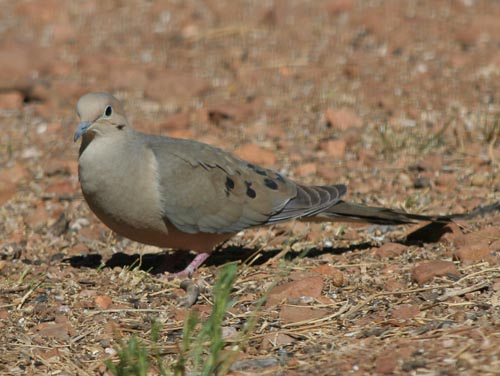
The Mourning Dove breeds from Bermuda, to southern Canada, Central America and the Caribbean, laying two white eggs on a flimsy platform built in a tree or shrub, sometimes on a building. These birds may raise six or more broods in a season. Eggs take approximately two weeks to hatch, and the young chicks typically fledge after only two weeks in the nest. Parents feed the young pigeon's milk, a nutrient rich substance regurgitated from its crop.
In many parts of the United States the Mourning Dove is hunted as a game bird. However, Mourning Doves are Wisconsin's official symbol of peace.
The bird is resident and abundant over much of its range, but many northern birds migrate south in winter. It is presumably Canadian birds which give rise to the very rare occurrences of this species in western Europe.
The Mourning Dove is approximately 31 cm (12 in) in length. It has a long tapered tail, and is greyish-brown above and pinkish below. The wings have black spotting, and the outer tail feathers are white. The male has bright purple-pink patches on the neck sides; these are less obvious in the female. Young birds have a scaly appearance.
This bird is found in a range of open and semi-open habitats. Its mournful cooOOoo-coo-coo call is familiar throughout its range, as is the whistling of its wings as it takes flight.
These birds forage on the ground, mainly eating grains and seeds, sometimes also on insects. They often swallow fine gravel to assist with digestion. At bird feeders, Mourning Doves are attracted to one of the largest ranges of seed types of any North American bird, with a preference for corn, millet, safflower, and sunflower chips.
Photo © Sean Cronin
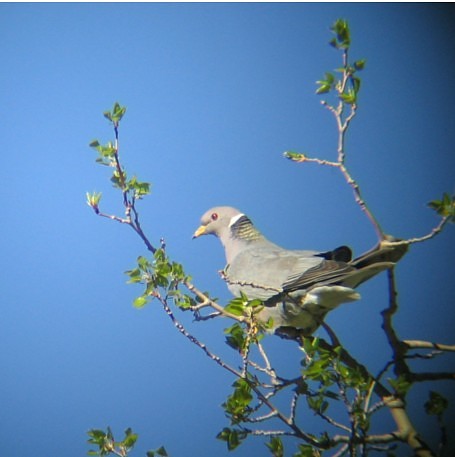
It ranges from British Columbia, Utah, and Colorado south in higher elevations through Mexico and Central America to northern Argentina. In autumn it migrates out of the part of its range north of California, New Mexico, and west Texas. Populations from Costa Rica south are sometimes considered a separate species, the White-naped Pigeon, C. albilinea. It is found at altitudes from 900 m to 3600 m, generally in oak, pine-oak, and coniferous forests. It feeds on seeds, notably acorns.
It is the biggest pigeon in North America, averaging 34 to 36 cm (14–15 in) long and weighing 250–450 g. The plumage is gray, somewhat darker above. The head and underparts have a faint pink cast, especially in the adult male; the belly is nearly white. The distal half of the tail is also pale (except in the subspecies of Baja California), whence the English name. The bill and feet are yellow, good identification marks at sufficiently close range. Adults have green iridescence on the back of the neck, adjacent to a thin white collar on the nape. Juvenile birds have white feather edges above, giving a scaly appearance.
This species is relatively quiet for a pigeon. Its voice is low-pitched and owl-like, often in two-syllable calls.
It builds a rudimentary platform nest out of twigs, in which it lays one or two eggs. Outside the breeding season it forms flocks, sometimes over 50 birds, and often becomes nomadic, following the acorn crop or moving to lower altitudes or other areas outside its breeding range. It often visits bird feeders.
Photo © Loch Kilpatrick
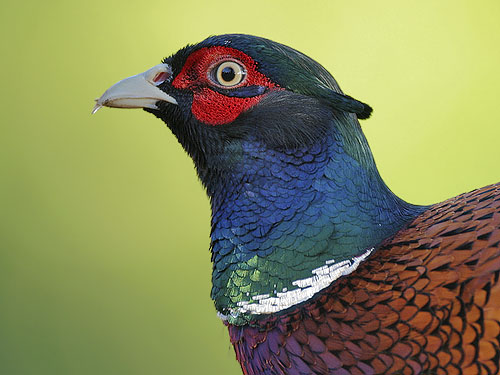
Pheasants are a group of large birds in the order Galliformes. In many countries they are hunted as game.
Pheasant are characterised by strong sexual dimorphism, with males being highly ornate with bright colours and adornments such as wattles and long tails. They are usually larger than the females. Males play no part in rearing the young.
There are 35 species of pheasant in 11 different genera. The best-known is the Ringnecked Pheasant (Phasianus colchicus torquatus) which is widespread throughout the world in introduced feral populations and in farm operations. Various other pheasant species are popular in aviaries, such as the Golden Pheasant (Chrysolophus pictus).
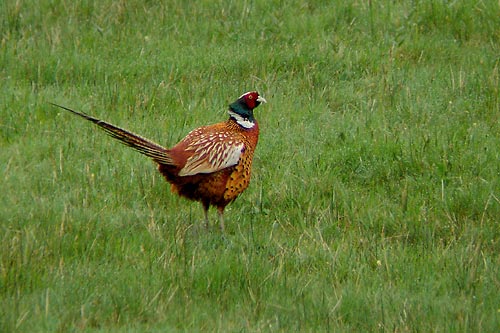
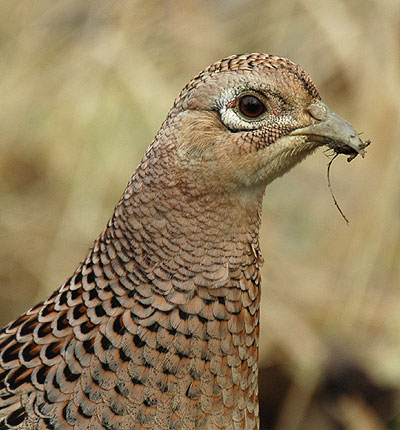
Photo © Steve Round
Photo © Stephen Menzie
Photo © Mike Lawrence
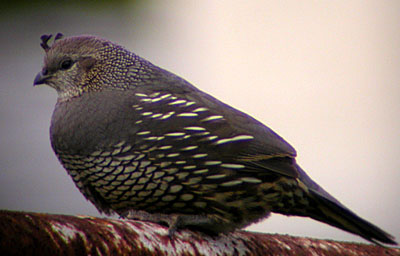
These birds have a curving crest that droops forward - black in males and brown for females; the flanks are brown with white streaks. Males have a dark brown cap and a black face with a brown back, a grey-blue chest and a light brown belly. Females and immature birds are mainly grey-brown with a light-colored belly.
Their breeding habitat is shrubby areas and open woodlands in western North America. The nest is a shallow scrape lined with vegetation located on the ground under a shrub or other cover. The female usually lays around 12 eggs. Once they are hatched, both parents look after the young.
They are permanent residents.
These birds forage on the ground, often scratching at the soil. They can sometimes be seen feeding at the sides of roads. Their diet consists mainly of seeds and leaves, but they also eat some berries and insects. If startled, these birds explode into short fast flight. Given a choice, they will normally make their escape on foot.
They often gather in small flocks known as "coveys". Although this bird coexists well at the edges of urban areas, it is declining in some areas as human populations increase. They were originally found mainly in the southwestern United States but they have been introduced into other areas including British Columbia, Hawaii, Chile and New Zealand.
The California Quail is a highly sociable bird and one of the daily communal activities is the taking of dust baths. A family of quail will select an area where the ground has been newly turned or is soft, and using their underbellies, will burrow downward into the soil some 1-2 inches. They then wriggle about in the indentations they have created, flapping their wings and ruffling their feathers, causing dust to rise in the air. They seem to prefer sunny places in which to create these dust baths, and an ornithologist is able to detect the presence of quail in an area by spotting the circular indentations left behind in the soft dirt, some 3-6" in diameter.
Photo © Andrew Birch
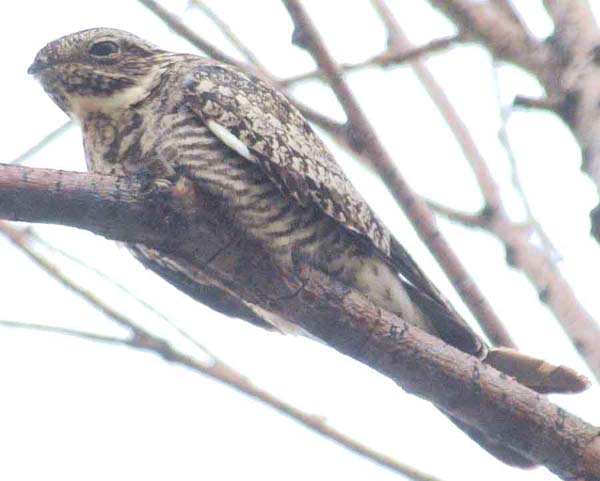
The adults are dark with brown, grey and white patterning on the upperparts and breast; the long wings are black and show a white bar in flight. The tail is dark with white barring; the underparts are white with black bars. The adult male has a white throat; the female has a light brown throat.
Their breeding habitat is open country across North America. They usually nest on bare ground, sometimes in raised locations including stumps or gravel roofs. They especially favor burned areas in forests. The two eggs are laid directly on bare ground--there is no nest. Incubation is performed largely by the female and lasts for about 20 days. Young fledge at about 20 days of age. There may be a second brood in the southern part of the United States.
These birds winter in South America. They migrate in flocks. The Common Nighthawk is a very rare vagrant to western Europe.
They catch flying insects on the wing, mainly foraging near dawn and dusk (crepuscular), sometimes at night with a full moon or near street lighting.
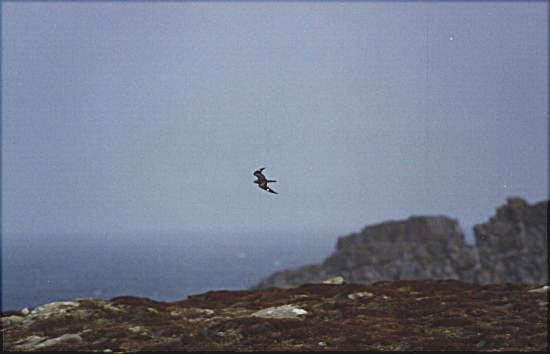
The call is a short peet usually heard overhead. The male performs an aerial display during courtship, creating a booming sound near the end of a steep dive. The sound is produced by air rushing through the wingtips.
Common Nighthawks are called bullbats in many parts of the United States. The origin of this name is not clear. The erratic flight and crepuscular habits of the nighthawk resemble those of bats. In addition, the name (perhaps bull) may refer to the loud booming sound of the male's display.
The scientific name for this species, minor, leads to some confusion. Originally this species was placed in genus Caprimulgus, and it is indeed smaller than some other members of that genus, such as the Whip-poor-will, Caprimulgus vociferus. However, with the Common Nighthawk moved to the genus Chordeiles, it is in the odd position of being named minor, even though it is larger than the Lesser Nighthawk, Chordeiles acutipennis.
Photo © John C. Folinsbee
Photo © Alan Shearman
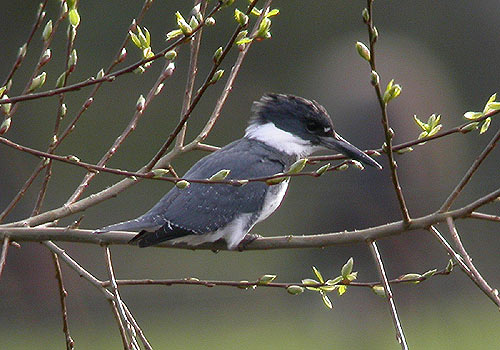
The Belted Kingfisher (Megaceryle alcyon) is a large, conspicuous and noisy kingfisher, the only member of that group commonly found in the northern United States and Canada.
This bird's breeding habitat is areas near inland bodies of waters or coasts across most of Canada, Alaska and the United States. In the winter, this bird leaves northern inland areas where the water freezes; in other parts of its range, these birds are permanent residents.
It is 28–36 cm long, with deep blue or bluish-gray plumage with white markings, a shaggy crest and a broad white collar around the neck. As shown in the photo, females have a rusty band along the sides of the belly, making this one of the less common cases found in North America where the female is more decorated than the male.
These birds nest in a horizontal tunnel made in a river bank or sand bank. The female lays 5 to 8 eggs. Both parents excavate the tunnel, incubate the eggs and feed the young.
It is often seen perched prominently on trees, posts, or other suitable watchpoints close to water before plunging in head first after its fish prey. They also eat small crustaceans, frogs, aquatic insects, small mammals, lizards and berries. These birds often give a rattling call as they fly overhead.
This bird migrates from the northern parts of its range to the southern United States, Mexico, Central America, the West Indies and northern South America, and has occurred as an extreme rarity in Iceland, Ireland and the UK.
The number of these birds appears to have declined, possibly as a result of habitat loss.
Photo © Darren Robson